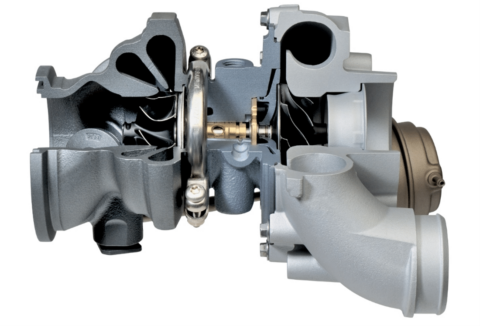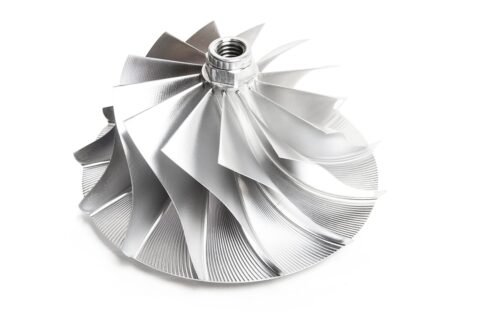Accessing the Knowledge Center effectively requires a simple, one-time registration.
Turbo Lag: Causes, Effects, and Solutions
In this article, we’ll be explaining what turbo lag is, covering the causes, effects, and how you can solve this issue by simply choosing a genuine Garrett product for your vehicle.

What is Turbo Lag?
Turbo lag is a delay in the response of a turbocharged engine when the driver accelerates. This is because the engine needs to produce enough exhaust gas pressure to spin the turbine and force compressed air to the engine intake manifold.
Turbochargers activate on specifically tuned RPM ranges. When hitting the throttle from idle, you may not experience an immediate torque boost. That’s turbo lag, and it’s normal. Step on the gas further, and you’ll find that the engine gives a noticeable power boost.
This phenomenon is a common occurrence in turbocharged engines and is influenced by various factors.
Causes of Turbo Lag
There are several factors that influence the causes of this problem.
Let’s explore some of these and offer some insights on why these happen:
Inertia and Mass: The turbocharger’s components need time to speed up with sudden acceleration.
Exhaust Flow: At low speeds, insufficient exhaust gas flow can delay the response.
Turbo Size: Larger models may increase power at high speeds but can exacerbate lag at lower speeds.
Compressor and Turbine Matching: The design of the compressor and turbine wheels, as well as the size and shape of the housing, must be matched to the engine’s characteristics. Poor matching can lead to inefficient performance and increased lag. (Such as larger turbine housing A/R which will allow greater exhaust gas mass flow at high output engine RPM but will have poor low speed response)
Learn how to select the right turbo for your vehicle here!
Wastegate Operation: Incorrect wastegate operation can lead to increased lag.
Intercooler Efficiency: An inefficient intercooler can slow down the cooling process, contributing the issue.
Learn more about Intercoolers and their role here!
Boost Threshold: This is the minimum RPM at which the turbo starts to boost the engine significantly.
Engine Management System: A well-tuned Engine Control Unit (ECU) can minimize the issue through optimal fuel and air delivery.
Types of Turbo Lag
There are multiple causes for turbo lag, however it is important to understand the types to properly find the best solution to fix it.
Low-End: Common at low engine speeds due to insufficient exhaust gas flow.
High-End: Occurs at high engine speeds, especially with larger turbos aimed at high performance.
Transient: The delay during rapid throttle changes, such as quick acceleration or deceleration.
Boost Threshold: The lag experienced before reaching the RPM that provides significant turbo boost.
Learn more about our Award-Winning E-turbo Technology and how it reduces Turbo Lag here!
Mechanical: Results from the time needed for turbo components to reach optimal speeds.
Sequential: In multi-turbo setups, the delay when switching from one turbo to another.
Effects of Turbo Lag on vehicles
Now that you understand what turbo lag is, it’s causes and the types, it is time to understand what the effects on vehicles are and how it impacts their performance and drivability:
Delayed Acceleration: The most noticeable effect, creating a pause when power is needed quickly.
Throttle Response: Turbo lag can make the throttle feel sluggish, disconnecting driver input from vehicle performance.
Unpredictable Handling: Sudden power surges from lag can affect vehicle handling, especially in dynamic driving conditions.
Reduced Fuel Efficiency: Lag can lead to inefficient driving, increasing fuel consumption as drivers compensate for the delay.
Increased Wear and Tear: Frequent heavy acceleration to overcome the issue can stress the engine and transmission.
Hesitation in Stop-and-Go Traffic: Turbo lag is more pronounced in stop-and-go traffic, affecting driving smoothness.
Safety Concerns: Delayed power delivery can pose safety risks during quick maneuvers.
Noise and Vibration: Some drivers may notice increased noise and vibration as the engine works harder to build power.
How to prevent Turbo Lag
Investing in a genuine Garrett turbo stands out as the best solution to reduce the challenges of turbo lag. Our commitment to cutting-edge technology and relentless pursuit of improvements makes our turbochargers the preferred choice for those seeking to eliminate turbo lag efficiently.
Variable Geometry Turbochargers (VNT): Utilizing adjustable vanes, VNTs dynamically optimize exhaust flow according to engine speed and load, enhancing low-end torque and ensuring peak performance across all RPMs. This adaptability cuts down the usual lag, offering a more responsive driving experience.
Learn more about VNT turbochargers here!

Garrett VNT turbocharger with movable vanes
Twin-Scroll Turbochargers: These turbochargers separate exhaust gas streams to reduce interference and speed up response times. By improving energy transfer to the turbine, they boost low-end torque and ensure smoother power delivery, making driving more predictable and enjoyable.

Garrett twin-scroll turbocharger
Ball Bearing Turbochargers: Garrett’s ball bearing turbos replace traditional bearings with advanced ball bearings, drastically lowering friction. This enhances spooling speed, nearly erasing turbo lag and delivering immediate throttle response for an instant power boost at various engine speeds.

Garrett Ball bearing Turbo
Why Garrett?
Choosing a non-original or cheaper turbocharger may seem budget-friendly, but it poses risks to vehicle performance and emissions. Garrett’s original turbochargers undergo precise engineering and calibration, ensuring compatibility with specific engines. Cheaper alternatives often lack this precision, leading to increased turbo lag due to improper calibration. This results in inefficient spoiling, delayed responses, and potential emissions issues. Investing in an authentic Garrett turbocharger guarantees optimal performance, reduced turbo lag, and compliance with emission standards. The long-term benefits outweigh short-term cost considerations associated with cheaper alternatives.
Conclusion
Understanding turbo lag and its impact on vehicle performance is crucial for both manufacturers and drivers. Technological advancements continue to mitigate turbo lag, enhancing the overall driving experience. By employing effective driving techniques and considering advancements in turbocharger technology, drivers can manage turbo lag and make the most of turbocharged engines.















